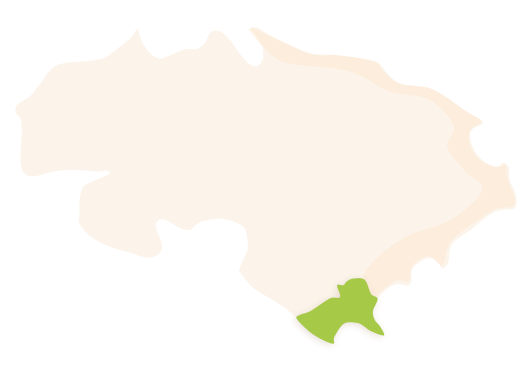Calp is the municipality located at the southernmost point of La Marina Alta. With a municipal area of 23.6 km2, distributed from the coast and the rock known as El Penyal d’Ifac to the east, to Oltà and the foothills of Bèrnia to the west. The natural bay of Calp is guarded by the famous outcrop to the east and El Morro de Toix to the west. The original town, located in the historic centre, is situated 59 metres above sea level and currently has 25,530 inhabitants, which puts it in first place at the regional level in terms of population density. The inhabitants are known as Calpins and Calpines.
 Calp's municipal district. Surface area: 23.6 km². Population: 25,530 (INE data 2021).
Calp's municipal district. Surface area: 23.6 km². Population: 25,530 (INE data 2021).HISTORY
The oldest vestiges found in the town date back to the Bronze Age and the Iberian period, located close to the Ifac rock and El Morro de Toix, although the period which stands out above the rest of the towns of La Marina Alta is the Roman era. There are, for example, some natural salt pans that were taken advantage of by the Romans, as well as an important site called Els Banys de la Reina, where there are remains of a Roman villa dating back to the end of the 2nd century with impressive mosaics preserved where the house had its main circular courtyard, as well as a Roman baths area, a noria for irrigation and an area for the extraction of blocks of tufa, as well as a fish farm used to keep fish alive and fresh so as to be able to turn them later into garum for commerce.
With regards to the origin of the name of the town, the president of the Onomastic Section of the Valencian Language Academy, Emili Casanova i Herrero, issued a report in which he pointed out that "the place name Calp, probably of pre-Roman origin, is the only form documented both in the Muslim era, spelled /Qalp/, and after Jaume I’s conquests and throughout the Middle Ages".
Little information exists about the long Islamic period. Christian tradition attributes the Christian conquest to Pere Eximenis d'en Carròs and Bernat Abella in 1240, after the capture of Dénia, but other historians incline more towards the year 1254. Whatever may be the truth, it is clear that it was not repopulated by Christians until after Al-Azraq’s revolt. Calp, along with other towns in La Marina Alta such as Dénia, Xàbia, Teulada and Pego, thereby became a town populated exclusively by so-called Old Christians (those who were not converts and could also prove that they were not descendents of Jewish or Muslim converts).
Another of Calp's characteristic historical features were the attacks carried out by corsairs and Barbary pirates, which took place continuously throughout the 17th century. On August 3rd, 1637, one of the most notable pirate attacks took place: 290 people were kidnapped and taken captive to Algiers, held there until five years later when they were released in exchange for gold and imprisoned pirates.
Calp is a town with a strong seafaring tradition that during the Seventies began a powerful development process based on tourism, creating a great urban expansion that ended up uniting the two traditional centres, the town and the port.
FESTIVITIES
- The patronal festivities in honour of La Mare de Déu de Les Neus are held on August 5th.
- The traditional Moors and Christians festivities of El Santíssim Crist De La Suor are celebrated from October 21st to October 24th.
- The festivities in honour of La Mare de Déu del Carme are celebrated on July 16th. The sailors of Calp organise a big celebration in honour of their patron saint.
GASTRONOMY
- Llauna de Calp is one of the most representative dishes of Calp’s cuisine. It is a simple dish prepared mainly with bay fish, potatoes and tomatoes.
- The arròs del senyoret dish (gentleman's rice) is also a local icon. Its name derives from a story which says that all the seafood and fish that was cooked was peeled so that the gentleman would not have to get his hands dirty.
- Blanquet is a seafood dish based on white fish. Fish such as the greater forkbeard or hake are typically used, accompanied by crabs and vegetables, and good noodles can be made with the broth.
- Another of Calp's gastronomic emblems that one shouldn’t miss out on is the white prawn.
- A well-rooted recipe in Calp, and especially in the country houses of the various rural parts of the municipality, is the coques dish made in a wood-fired oven and accompanied by local grapes.